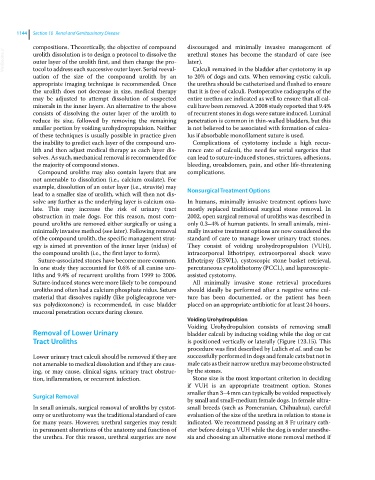Page 1206 - Clinical Small Animal Internal Medicine
P. 1206
1144 Section 10 Renal and Genitourinary Disease
compositions. Theoretically, the objective of compound discouraged and minimally invasive management of
VetBooks.ir urolith dissolution is to design a protocol to dissolve the urethral stones has become the standard of care (see
later).
outer layer of the urolith first, and then change the pro
Calculi remained in the bladder after cystotomy in up
tocol to address each successive outer layer. Serial reeval
uation of the size of the compound urolith by an to 20% of dogs and cats. When removing cystic calculi,
appropriate imaging technique is recommended. Once the urethra should be catheterized and flushed to ensure
the urolith does not decrease in size, medical therapy that it is free of calculi. Postoperative radiographs of the
may be adjusted to attempt dissolution of suspected entire urethra are indicated as well to ensure that all cal
minerals in the inner layers. An alternative to the above culi have been removed. A 2008 study reported that 9.4%
consists of dissolving the outer layer of the urolith to of recurrent stones in dogs were suture induced. Luminal
reduce its size, followed by removing the remaining penetration is common in thin‐walled bladders, but this
smaller portion by voiding urohydropropulsion. Neither is not believed to be associated with formation of calcu
of these techniques is usually possible in practice given lus if absorbable monofilament suture is used.
the inability to predict each layer of the compound uro Complications of cystotomy include a high recur
lith and then adjust medical therapy as each layer dis rence rate of calculi, the need for serial surgeries that
solves. As such, mechanical removal is recommended for can lead to suture‐induced stones, strictures, adhesions,
the majority of compound stones. bleeding, uroabdomen, pain, and other life‐threatening
Compound uroliths may also contain layers that are complications.
not amenable to dissolution (i.e., calcium oxalate). For
example, dissolution of an outer layer (i.e., struvite) may Nonsurgical Treatment Options
lead to a smaller size of urolith, which will then not dis
solve any further as the underlying layer is calcium oxa In humans, minimally invasive treatment options have
late. This may increase the risk of urinary tract mostly replaced traditional surgical stone removal. In
obstruction in male dogs. For this reason, most com 2002, open surgical removal of uroliths was described in
pound uroliths are removed either surgically or using a only 0.3–4% of human patients. In small animals, mini
minimally invasive method (see later). Following removal mally invasive treatment options are now considered the
of the compound urolith, the specific management strat standard of care to manage lower urinary tract stones.
egy is aimed at prevention of the inner layer (nidus) of They consist of voiding urohydropropulsion (VUH),
the compound urolith (i.e., the first layer to form). intracorporeal lithotripsy, extracorporeal shock wave
Suture‐associated stones have become more common. lithotripsy (ESWL), cystoscopic stone basket retrieval,
In one study they accounted for 0.6% of all canine uro percutaneous cystolithotomy (PCCL), and laparoscopic‐
liths and 9.4% of recurrent uroliths from 1999 to 2006. assisted cystotomy.
Suture‐induced stones were more likely to be compound All minimally invasive stone retrieval procedures
uroliths and often had a calcium phosphate nidus. Suture should ideally be performed after a negative urine cul
material that dissolves rapidly (like poliglecaprone ver ture has been documented, or the patient has been
sus polydioxonone) is recommended, in case bladder placed on an appropriate antibiotic for at least 24 hours.
mucosal penetration occurs during closure.
Voiding Urohydropulsion
Voiding Urohydropulsion consists of removing small
Removal of Lower Urinary bladder calculi by inducing voiding while the dog or cat
Tract Uroliths is positioned vertically or laterally (Figure 123.15). This
procedure was first described by Lulich et al. and can be
Lower urinary tract calculi should be removed if they are successfully performed in dogs and female cats but not in
not amenable to medical dissolution and if they are caus male cats as their narrow urethra may become obstructed
ing, or may cause, clinical signs, urinary tract obstruc by the stones.
tion, inflammation, or recurrent infection. Stone size is the most important criterion in deciding
if VUH is an appropriate treatment option. Stones
smaller than 3–4 mm can typically be voided respectively
Surgical Removal
by small and small‐medium female dogs. In female ultra‐
In small animals, surgical removal of uroliths by cystot small breeds (such as Pomeranian, Chihuahua), careful
omy or urethrotomy was the traditional standard of care evaluation of the size of the urethra in relation to stone is
for many years. However, urethral surgeries may result indicated. We recommend passing an 8 Fr urinary cath
in permanent alterations of the anatomy and function of eter before doing a VUH while the dog is under anesthe
the urethra. For this reason, urethral surgeries are now sia and choosing an alternative stone removal method if

